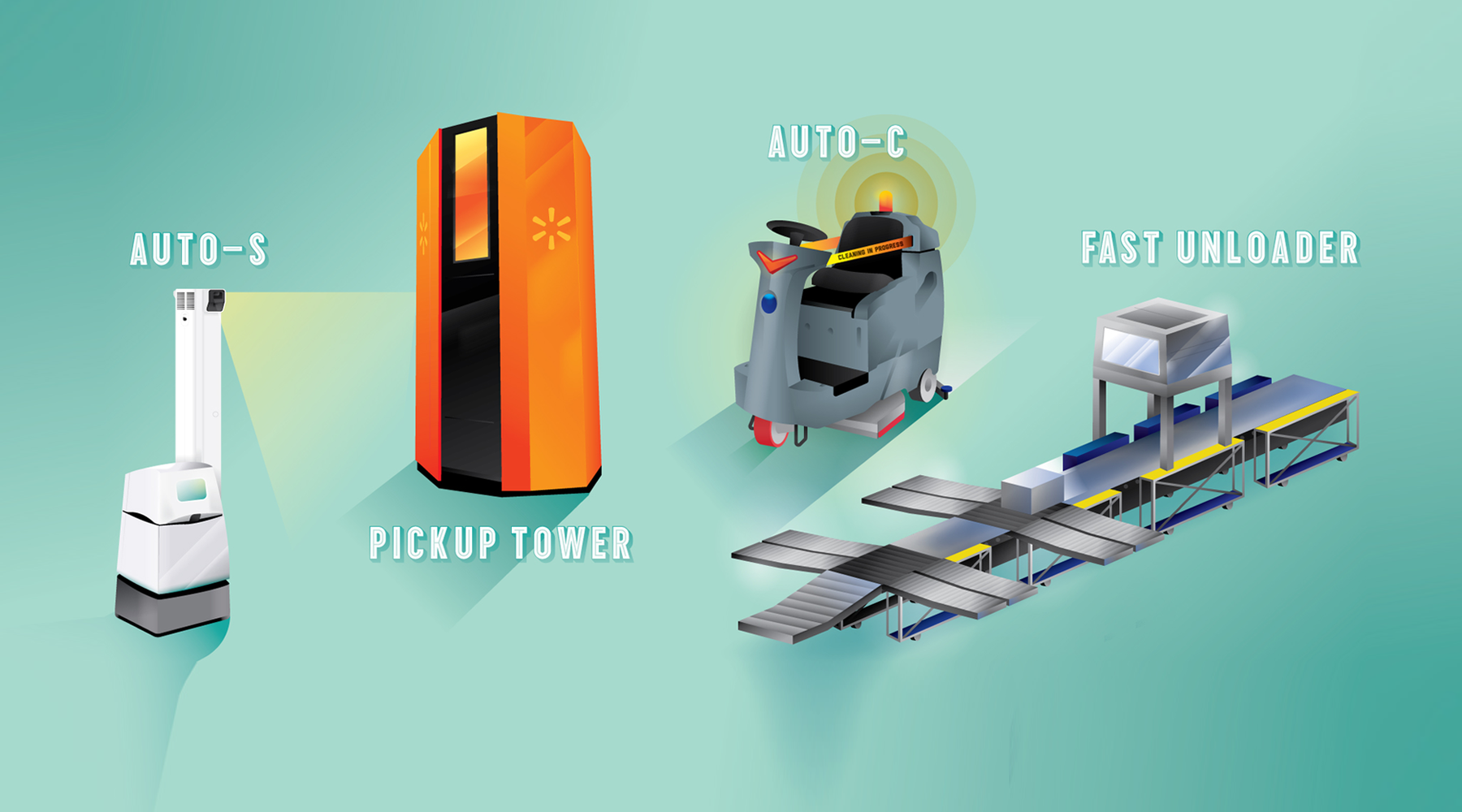Part III: Hungry for savings
This story is part of a collaboration with Slate called “The Secret Life of a Food Stamp.”
Karrie Denniston is standing in the meat department of a Walmart Supercenter peering at the sell-by dates on a stack of pork chops. Denniston, director of hunger relief and nutrition programs at the Walmart Foundation, is at Walmart’s “Store 100,” the showcase Supercenter across the street from company headquarters in Bentonville, Ark. Store 100 is one of thousands of Walmart locations where the company collects billions of pounds of vegetables, dry goods, and other items for its food-donation program. Every day, as part of its anti-hunger initiative, Walmart associates scour the shelves looking for food that falls into a donation sweet spot: just past its sell-by date but still safe to eat.
Karrie Denniston of the Walmart foundation.
Walmart—which in 2012 made a five-year pledge to donate $2 billion in cash and food to fight hunger—works with local food banks to distribute the meat, in a system of carefully temperature-controlled steps. Denniston holds up a family pack of pork chops. If no one buys it before its sell-by date, “that meat may end up as part of a stew at a local soup kitchen, or it may end up being distributed at a food pantry to a mom so that she can make tacos for her kids,” she says.
Some of Walmart’s donations end up on the shelves of the Lutheran Social Services food pantry in Columbus, Ohio. “Walmart, Save-a-Lot, Giant Eagle, Kroger, they all send a lot of food back here,” volunteer Jordan Moore says. The donations are “a blessing,” he says.
But there can be moments that throw him. Recently, a shopper at the food pantry took an item off a shelf and told Moore, “I put this on the shelf, too.” The shopper was a Walmart worker.
“It’s this cycle that keeps going around and around,” says Jason Elchert, deputy director for the Ohio Association of Foodbanks. “We need to take a deep breath and think about how can we move our country forward.” Elchert says that over the past few years more and more working people in need of food assistance have been showing up at the charities his group serves. These include workers whose food stamps have run out before the end of the month as well as people who still can’t make ends meet even though they make too much to qualify for government food assistance. (The Supplemental Nutrition Assistance Program, the formal name for food stamps, has an annual gross income cap of just under $25,400 for a household of three.)
Like many anti-hunger advocates who receive donations from corporate retailers known for low wages, Elchert is in a tricky spot when it comes to addressing the paradoxes of the food stamp economy. His group gets financial support from Walmart and other food retailers. “When we’re talking a lot with corporations,” he says, “it’s one of those situations where, well, let’s talk about this in some way where we’re not offending them.”
Matt Habash, president of the Mid-Ohio Foodbank—which has representatives from retail companies including Kroger and Giant Eagle supermarkets on its board—has tried to broach the issue of low wages with his corporate supporters. At a recent board meeting, Habash brought up the idea of promoting a living wage as part of the food bank’s mission. “Some of the folks in that room were employers who knew their wages were not” living wages, Habash says. “They were willing to engage in the conversation,” he says. “But no one employer can do it on their own.”
Wages might be a sensitive issue to tackle, but there is one cause many big retailers have already come together on: protecting funding for SNAP. The program, which gives low-income families an average of $130 a month in food assistance, is lucrative for stores; food stamps accounted for $76 billion in store revenue in 2013.
But spending on the program has become the subject of protracted debates in recent years as food stamp rolls have soared, largely in response to the poor economy. Congress voted earlier this year to cut $8 billion from SNAP over the next decade, after House Republicans gave up their fight for much larger cuts (that would have reached nearly $40 billion).
In the middle of the battles over food stamp funding, the Ohio Grocers Association sent Congress a joint letter with the state’s Association of Food Banks. They wrote, “Cutting SNAP doesn’t just hurt the poor, it hurts business too.”
Food banks receive a sizeable proportion of their donations from big stores like Walmart.
“You tend to think that larger retail chains, with their corporate culture and perspective, might be less inclined to support a large, federal program, but certainly on the other side, these programs benefit them tremendously,” says Julie Paradis, former administrator of the Food and Nutrition Service at the Department of Agriculture, which oversees the food stamp program.
Toward the end of the SNAP funding debates in January, I met with Rep. Marcy Kaptur, a Democrat from Ohio (and the daughter of a grocer) who was working to persuade her Republican colleagues to minimize the food stamp cuts. “Walmart is a helpful force, as well as many other retail stores. All the big retailers, the grocers, make a great deal of money” from SNAP, she said.
Walmart confirms it takes in about 18 percent of U.S. food stamp dollars, a share that would have amounted to more than $13 billion last year. Walmart spokesman David Tovar told me the company did not take a position on the recent food stamp funding cuts but that it likes to be “part of the dialogue” to help elected officials consider the issue of food stamp funding. “We oftentimes will provide useful information about our business, some of the trends we’re seeing, how it’s impacting customers,” Tovar says.
But public lobbying records suggest Walmart is playing a more active role in those discussions. Disclosure forms for the end of 2013, when debate over SNAP funding was in full swing, show that Walmart paid in-house lobbyists $1.9 million. The report itemizes lobbying activity on a broad range of issues, among them SNAP, the farm bill legislation that determines SNAP funding levels, and “discussions regarding Federal Nutrition programs from the consumer and retail perspective.”
Further down the lobbying form, Walmart also disclosed discussing the minimum wage. (Walmart says that it has not taken a stand on the proposed raise to the federal minimum wage to $10.10 but that it’s looking into the effect it would have on its business.)
If you go to Walmart’s headquarters in Bentonville, in a drab brick building that looks more like a public school than a corporate HQ, you will probably hear at least one person quote a certain Walmart aphorism: “EDLC equals EDLP.” Translation: “Every Day Low Costs” equal “Every Day Low Prices.” That’s part of why discount retailers like Walmart take in so many food stamp dollars in the first place, as low-income customers look to get the most bang for their food stamp bucks.
You can think about that equation two different ways. Walmart sees its low prices as a chief force in fighting hunger, says Denniston of the Walmart Foundation. “We want to take the best of what Walmart as a business has to offer and build on that,” she says, “and so one of the greatest assets that we provide to local communities is being a grocer that can bring safe, affordable, nutritious products.”
But one of the Every Day Low Costs that Walmart needs to keep in check is the price of labor. In the EDLC = EDLP equation, low wages help make low prices possible—and if that means some companies don’t pay their workers enough to make ends meet, it’s the government that makes up the difference.
Additional reporting and production on this story from Jolie Myers and Martha Little.
Part Two: The Secret Life of a Food Stamp
There’s a lot happening in the world. Through it all, Marketplace is here for you.
You rely on Marketplace to break down the world’s events and tell you how it affects you in a fact-based, approachable way. We rely on your financial support to keep making that possible.
Your donation today powers the independent journalism that you rely on. For just $5/month, you can help sustain Marketplace so we can keep reporting on the things that matter to you.


















